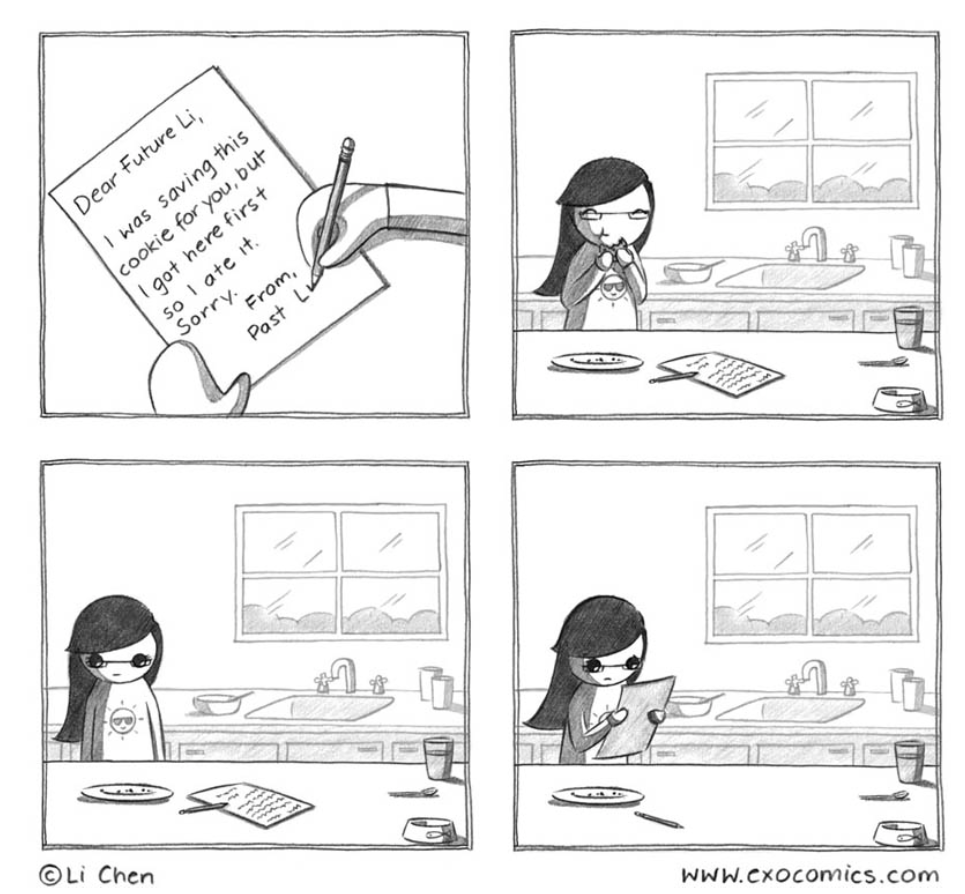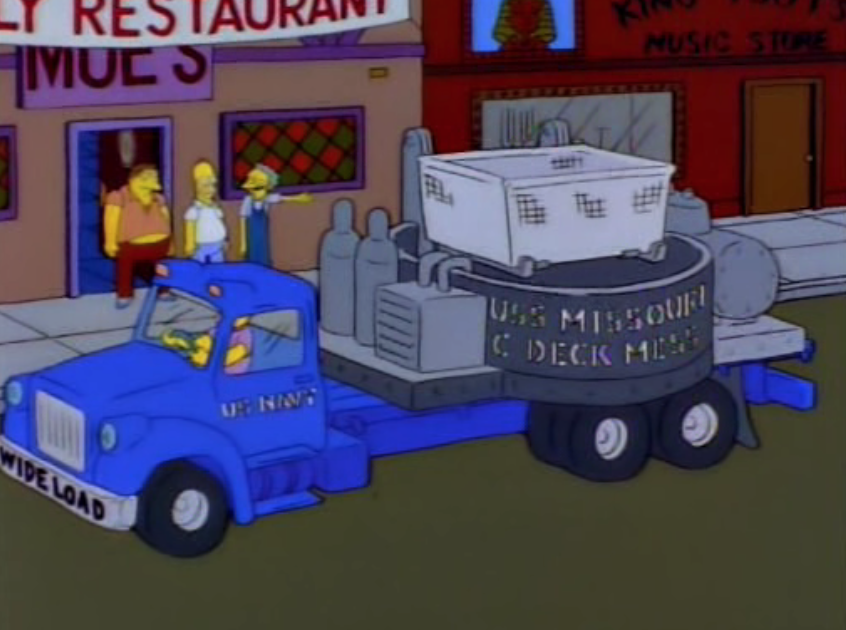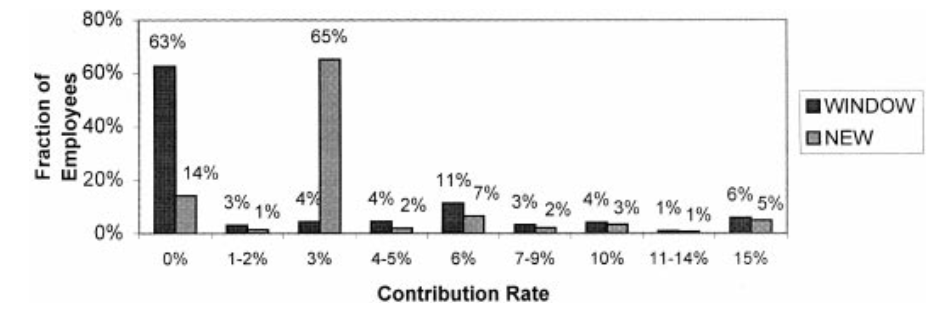Predictably Misbehaving
Lecture 5: Choice Over Time (Again)
Joshua Foster at UW-Oshkosh

Multiple Selves Approach


Moe: Oh, boy! The deep fryer's here. Heheh, I got it used from the navy. You can flash-fry a buffalo in forty seconds.
Homer: Forty seconds?!? But I want it now!
Extreme assumptions of behavior over time
Naivete:
An individual who does not realize they will change their mind. That is, they assume their future self will follow through on their (current) preferred plan.
Sophistication:
An individual who understands perfectly that they will change their mind, and does the best given future self's anticipated behavior.
How could we tell whether someone is naive or sophisticated?
- The use of commitment devices indicates sophistication.
- Ulysses is (at least partly) sophisticated.
- Misprediction of future behavior indicates naivete.
- Teenage smokers who predict that they will not be smoking in five years have a slightly higher probability of smoking (74%) than those who predict they will be smoking (72%).
(BTW, non-issue under dynamic consistency.)
Naivete Vs. Sophistication
Ex: When to quit smoking
Naive decision-makers:
- Start at the beginning (i.e. first time step).
- Solve for the optimal plan at that time step.
- (Assuming future selves will follow the plan.)
- The person takes the first step in that plan.
- Go to the next period and repeat.
Ex: When to quit smoking
Sophisticated decision-makers:
- Start at the end (i.e. last time step).
- Solve for optimal action.
- (Assuming the person made it that far.)
- Go back to the previous period.
- Solve for the optimal action, taking into account what happens in the future.
- Go back to the previous period, and repeat.
Applications of Hyperbolic Discounting


Default Effects
Madrian and Shea (2001) QJE 401(k) Participation
- These plans are offered by many employers.
- Primary way to privately save for retirement.
- Employees often decide themselves:
- How much of their pay to allocate to the 401(k)
- How to invest their funds.
- This company offered a match (up to 6% of income):
- For every $1 an employee put in their 401(k)
- The company added 50 cents.
On April 1, 1998, the company changed their policy.
Before:
- Employees could participate after one year.
- Were not automatically enrolled.
- (Could enroll easily at any time.)
After:
- All employees were immediately eligible.
- And they were automatically enrolled.
- (Could unenroll easily at any time.)
The authors compare the choices of these groups:
- "Window" cohort: those hired in 1998 before April 1
- (Not automatically enrolled.)
- "New" cohort: those hired in 1998 after April 1
- (Automatically enrolled.)
Results: Participation and Contribution Rates
Participation rates 3-15 months after being hired:
- 37% for the Window cohort
- 86% for the New cohort
The contribution rates were as follows:

The finding that defaults matter is one of the most important discoveries in applied microeconomics.
Getting a Grip on the Default Effect
This appears to be a big mistake by not participating.
- Offered a 50% return on up to 6% of your income.
Example: for an employee making $40,000.
- That's giving up a $1,200 gift from the company.
Even if it is not a mistake, why does the default matter so much?
- It only takes a phone call to change enrollment.
Would people not bother making a phone call for $1,200?
- If they are naive hyperbolic discounters, they might not.
- And as a result, defaults can be extremely important.
Making the Call:
"I'll do it tomorrow"
Costs and Benefits of Making the Call:
- Benefit: will get 5 per day (1,825 per year) extra for the next 30 years starting tomorrow.
- Cost: pain of the phone call today costs 30
Assume a naive hyperbolic discounter discounts the future at 80%.
When to make the call:
- Today: $-30+0.8\cdot[5\cdot 365\cdot 30] = 43770$
- Tomorrow: $0+0.8\cdot[-30+5\cdot 365\cdot 30 - 5] = 43772$
Hence, they put off making the phone call.
- If nothing changes they put off the phone call forever.
"I'll do it this week"
(Really, I will)
This prediction is extreme - and it's because the model is extreme.
- More reasonable prediction might be they delay for a long time.
Let's change the model:
- What would a sophisticate do?
- It's easy to argue they'd do it within a week.
- Waiting 8 days costs 40, valued at $0.8\cdot 40=32$
- Would rather pay the 30 cost today to avoid this outcome.
When exactly they make the call is a more difficult question.
Other Studies on Procrastination
Choi, et al. (2004) in NBER
- 401(k) contribution patterns generalize.
- Remarkably similar results across three industries.
Other Studies on Procrastination
Cronqvist and Thaler (2004) in AER:
- Looks at privatized retirement funds in Sweden.
- Heavily advertised by the government - 456 plans.
- Initially, 43% of participants chose the default.
- After 3 years, 92% of participants chose the default.
Other Studies on Procrastination
DellaVigna and Malmendier (2006) in AER:
- Study gym-goers' behavior at three US health clubs.
- Customers had two options for how to pay:
- Monthly fee of ~80 for unlimited use.
- Pay-per-visit fee of 10.
Most choose the monthly contract (89%)
- Those who do exercise 4.8 times/month (average)
- That's about 17 per visit.
Default Effect: go 2.31 months (average) without using membership before canceling.
It can be argued these findings are consistent with both extreme assumptions of hyperbolic discounting.
Naive hyperbolic discounters:
- Gym-goers prefer they exercise a lot in the future.
- Being naive, that's what they think they'll do.
- To save money on gym they buy the monthly membership.
- Short-run impatience kicks in, and they don't use the membership much.
Sophisticated hyperbolic discounters:
- Also prefer to exercise a lot in the future, but realize they won't.
- Use the monthly membership as a commitment tool.
- Willing to pay more (per-visit) if it helps get them to the gym.
Credit Card Teasers
Ausubel (1991) in AER
- Large experiment run by a credit card company.
- Mailed randomized credit card offers of three types:
- Standard: 6.9% rate for six months and then 16%.
- Teaser deal: 4.9% followed by 16%.
- Post-teaser deal: 6.9% followed by 14%.
- 21 months of data on take-ups and borrowing debt.
- Results:
- Teaser is 2.5 more successful than Post-teaser
- Given behavior, Post-teaser is a much better deal.
Credit Card Teasers
Explanations
Possible explanations from hyperbolic discounting:
- Naive borrowers believe they'll repay quickly.
- Hence the teaser interest rate is most important.
- Sophisticated borrowers don't want to use their credit cards much in the future.
- Hence choose a high interest rate to restrain future borrowing.